| کد مقاله | کد نشریه | سال انتشار | مقاله انگلیسی | نسخه تمام متن |
|---|---|---|---|---|
| 2024547 | 1542600 | 2015 | 13 صفحه PDF | دانلود رایگان |

• Siliceous and calcareous glacier-forefield soils act as a sink for atmospheric CH4.
• Soil CH4 sink strength increases with soil age regardless of bedrock type.
• Distinct CH4 oxidizing bacterial communities offer a similar ecosystem service.
In upland soils aerobic methane-oxidizing bacteria (MOB) catalyze methane (CH4) oxidation, and thus regulate the sole terrestrial sink for atmospheric CH4. While confirmed in mature upland soils, little is known about this important function in young mountainous soils in glacier forefields, which are progressively formed as a result of glacier recession. We assessed four attributes of the soil CH4 sink, i.e., soil-atmosphere CH4 flux (Jatm), CH4 oxidation activity (k), MOB abundance and variation in community composition along the 6–120-yr soil chronosequence in two Alpine glacier forefields on siliceous and calcareous bedrock. At most sampling locations soil CH4 profiles showed stable uptake of atmospheric CH4, with Jatm in the range of −0.082 to −2.2 mg CH4 m−2 d−1. Multiple-linear-regression analyses indicated that Jatm significantly increased with soil age, whereas k did not. Instead, water content and CH4 profiles in the youngest soils often indicated dry, inactive top layers with k < 0.1 h−1, and active deeper layers (0.2 h−1 ≤ k ≤ 11 h−1) with more favorable water content. With increasing soil age the zone of highest CH4 oxidation activity gradually moved upwards and eventually focused in the 10–40-cm layer (0.2 h−1 ≤ k ≤ 16 h−1). Copy numbers of pmoA genes significantly increased with soil age at both sites, ranging from 2.4 × 103 to 5.5 × 105 copies (g soil w.w.)−1, but also correlated with mineral nitrogen content. Terminal restriction-fragment-length-polymorphism and cluster analyses showed differences in MOB community composition apparently related to bedrock type rather than soil age. Yet, regardless of bedrock type, the soil CH4 sink established within a few years of soil development, and Jatm increased to values comparable to mature soils within decades. Thus, young mountainous soils have the potential to consume substantial amounts of atmospheric CH4, and should be incorporated into future estimates of global soil CH4 uptake.
Journal: Soil Biology and Biochemistry - Volume 84, May 2015, Pages 83–95